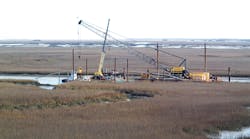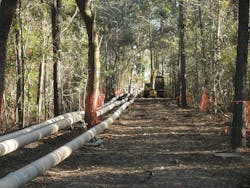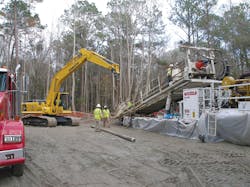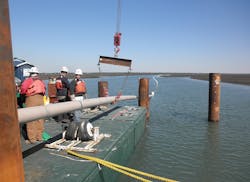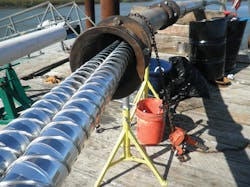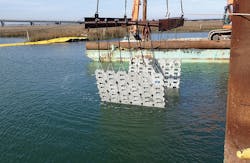The coast of South Carolina is a unique and sought-after location to live and visit. According to 2010 census data, the town of Mount Pleasant experienced a 42.5% growth in the past 10 years. And the growth continues. With a population at 67,843, Mount Pleasant is ranked the fourth-largest city in South Carolina.
Dubbed an all-American city, Mount Pleasant has shown the ability to innovate in areas such as job creation, neighborhood revitalization, crime reduction, low-income housing, improved education and engaged youth. Mount Pleasant is minutes away from the island towns of Isle of Palms and Sullivan’s Island, both of which have been well-kept “secret” destinations for fisherman and beachgoers for generations. For South Carolina Electric & Gas (SCE&G), the Mount Pleasant area offers many challenges to deliver electricity to two distinct load centers based on growth, population density and geographic location.
Grid Reinforcement
To better serve its growing number of customers and to provide greater service reliability, SCE&G proposed a new 115-kV electrical transmission line in 2007 called the Hamlin 115-kV tie line. After a series of public workshops as part of the siting process, property owners were notified and preliminary surveying began. The original route was only in Mount Pleasant, with the majority of the line being overhead and one short underground portion to accommodate a local airstrip glide path.
At the request of the Town of Mount Pleasant, from 2007 to 2009, SCE&G studied the option of placing a larger section of the line underground. In 2009, SCE&G began to investigate additional underground options that would place three existing radially fed substations into a loop system arrangement, embarking SCE&G on the largest underground high-voltage transmission project in company history.
With rapid advances in the technology used to construct and maintain underground transmission lines, SCE&G evaluated the plans for the Hamlin 115-kV tie line. After careful study, SCE&G determined the best plan for the overall electrical system in this area would be to construct a new 5-mile (8-km) underground paper-insulated high-pressure gas-filled (HPGF) transmission line between the Isle of Palms substation and the future Hungryneck substation, which was donated by the Town of Mount Pleasant to offset a portion of the costs for the 5-mile underground section. Of course when underground cables fail, the time to repair is longer than overhead construction. And to satisfy (N-2) contingency criteria, the remaining 1 mile (0.6 km) back to the Hamlin substation would be standard 115-kV overhead construction.
Creating a transmission loop offers benefits over the previously configured radial feeds.
Project Specifics
The 5-mile section of line would be the longest underground transmission line on SCE&G’s transmission system. In addition, the proposed route crossed 18,000 ft (5.5 km) of tidal marsh near Hamlin Sound, a crossing distance much greater than any other lowland/marsh or river crossing attempted by SCE&G in the past. Viewed in its entirety, the project was very large in scope, but when the 18,000-ft marsh crossing was broken down into three shorter drills — by installing two temporary work platforms in Hamlin Creek — none of the three crossings exceeded 7400 ft (2255 m). Based on the familiarity and success of other projects with horizontal directional drills of similar lengths, SCE&G was confident the project could be completed.
Work Platforms
The two temporary work platforms located in Hamlin Creek had to be capable of conducting horizontal drill, pipe pullback, cable pull, cable splicing, pipe overboarding and pipe burying operations. The temporary work platforms were constructed to withstand the lateral forces (up to 150,000 lb [68,000 kg]) associated with steel pipe pullback operations.
The platforms were designed to be large enough to accommodate equipment such as winch trucks, vacuum trucks, track hoes and cranes, and had to be adaptable to different needs in the project timeline. Essentially, the team was forced to build temporary high ground for a work station in the middle of Hamlin Creek. All the equipment typically needed to support a project of this magnitude on high ground had to be placed on the temporary work platforms. This was all done while keeping Hamlin Creek open for recreational boat traffic related to fishing and oyster harvesting. Pipe pullback into the horizontally directional drilled alignment was challenging because of the location of these temporary work platforms.
In the tidal marsh area, steel pipe stringers are floated into Hamlin Sound for pipe pullback into horizontal directional drilled holes in the earth.
Pipe and Cable Installation
SCE&G was able to communicate, cooperate and compromise with local property owners for the construction of pipe stringers, which are long sections of pipe that have been welded together and are ready for installation into the earth via pipe pullback. Using custom-made pipe floats for buoyancy, the team floated pipe stringers out into Hamlin Sound, aligned the pipe stringers with the horizontal drill alignments, and pulled the pipe stringers into the horizontally directional drilled holes in the earth.
The floating of the pipe for pullback into the drill alignments could not be accomplished during a single high tide. Therefore, the pipe was strategically placed in areas that would have minimal impact to oyster beds when the pipe rested on the bottom of the sound. The oyster bed areas were mapped and shown on construction drawings. The pipe was not moved once it was resting on the bottom of the sound. This also protected the external pipe coating from damage by restricting the movement of the pipe to times when the pipe was floating.
Once the HPGF cable was pulled inside the steel pipe, spliced on the platforms, and the steel pipe was sealed and coated, the team overboarded the pipe from the temporary platform to rest in a 4-ft (1.2-m) trench that had been excavated in the bottom of Hamlin Creek. When the team overboarded the pipe, the pipe that was in a vertical curve was rotated into a horizontal curve. This was done while jetting at the locations where the pipe entered the bottom of Hamlin Creek to prevent kinking. The pipe was covered with soil and flexible concrete mats were placed on top of the pipe for additional protection. Divers were placed in the creek to ensure that the pipe and the concrete mats were in the desired locations. All of the pipe overboarding operations were performed with turbidity curtains in place around the disturbed areas in accordance with Department of Health and Environmental Control Ocean and Coastal Resource Management (DHEC OCRM) and U.S. Army Corps requirements.
Flexible concrete mats are placed on top of the backfilled trench and pipe in the tidal creek for protection from damage.
Capacity, Reliability and Teamwork
The Hamlin-Isle of Palms 115-kV line allows SCE&G to provide greater reliability and meet the growing electrical needs of northern Mount Pleasant and Isle of Palms/Sullivan’s Island by providing a back-up source of power for three existing substations. This new transmission line also allows for greater flexibility in the way SCE&G operates the transmission system in Mount Pleasant. The new line also has enabled the rebuild of other overhead transmission lines in the area that could not take extended outages before the completion of this project.
The project had an estimated 18-month construction schedule and took 16 months to complete. The project came in under the projected estimate of US$35 million to complete.
SCE&G had the insight to know early in the project that this would be a project unlike any other the utility had ever attempted. To minimize the utility’s risk associated with this project, SCE&G used Cornerstone Surveying & Engineering along with Haley & Aldrich and Power Delivery Consultants to help design and engineer the plans to 60% of design completion. These plans were used to bid the project and were communicated to be 60% design complete at the project pre-bid meeting. The prime contractor would be required to take the design to 100% completion. The final construction drawings were then stamped and sealed by a professional engineer registered in the state of South Carolina. UTEC Constructors was selected as the prime contractor and was responsible for 100% design completion of the project, along with commissioning and testing of the transmission cable system upon construction completion. UTEC used POWER Engineers to fulfill the design completion requirements. UTEC also used other construction subcontractors, including Michels Corp., Salmons Dredging and Chapman Construction, to make the project a success.
The successful completion of this project is exciting for both the pipe-type underground industry and the utility industry. It gives utilities another proven technology to meet the needs of their customers. ♦
Mike Pridmore is the manager of the electric transmission engineering department at South Carolina Electric & Gas. He previously worked in transmission engineering and electric distribution operations. Prior to joining SCE&G, Pridmore worked for Duke Energy as a transmission line engineer. He holds BSCE and MSCE degrees from Clemson University and is a registered professional engineer in the state of South Carolina.
Brett Varner is the manager of power delivery engineering at South Carolina Electric & Gas. He previously worked as a manager in both transmission engineering and distribution operations, responsible for the design of projects from conception to as-built. Varner holds a BSME degree from Clemson University and an MBA degree from the University of South Carolina. He is a registered professional engineer in the state of South Carolina.
